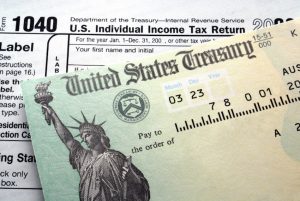By Rachel Christian
If you’re one of the 32 million Americans who experience vision loss, you can  reduce the amount you owe the IRS by simply checking a box when filing your tax return this year.
reduce the amount you owe the IRS by simply checking a box when filing your tax return this year.
It may even boost your tax refund.
The tax deduction for the legally blind is an increase to the standard deduction. It’s meant to offset some of the extra costs associated with blindness, was established nearly 80 years ago through the Revenue Act of 1943 (page 36).
For the 2020 tax year, the legally blind tax deduction is:
- $1,650 for single or head of household filers.
- $1,300 for married couples filing jointly or separately with one blind spouse.
- $2,600 for married couples filing jointly with two blind spouses.
People ages 65 and older also qualify for a similar tax deduction. If you’re blind and over 65, you can stack these deductions and qualify for both. The IRS offers free programs in communities across the country that can help you file your return before the April 15 deadline and claim these tax breaks.
Why the Blind Receive a Tax Break and Who Qualifies
Vision loss is one of the top 10 disabilities among adults, according to the Centers for Disease Control and Prevention.
Living with vision impairment isn’t easy — and it isn’t cheap.
“There are many hidden costs to having a disability,” said Tom Foley, Executive Director of National Disability Institute (NDI), the only national organization exclusively focused on the financial wellness of people with disabilities.
Readers, guides, visual aids and public transportation are just some of the expenses people with vision loss face. They may also struggle to find and maintain gainful employment or may incur higher rent prices in order to live within walking distance of work.
Foley said a higher standard tax deduction is Uncle Sam’s way of acknowledging these costs. “It was the first time the government recognized that blind people had additional expenses,” said Foley, who also serves as a tax lawyer with more than 30 years of experience as a blind advocate. “It’s a way to help compensate for those costs.”
The government uses a specific definition of blindness to determine eligibility for vocational training, rehabilitation, disability benefits — and yes, tax breaks.
To qualify for the deduction, one of the following must apply:
- You can’t see better than 20/200 in your better eye, even with glasses or contact lenses.
- Your field of vision is 20 degrees or less.
- You have no eyesight at all.
IRS Publication 501, pages 22-23, gives more guidance on this.
You must be considered legally blind on the last day of the prior year to get the deduction. If you’re disabled, you may qualify for other tax breaks — including the Earned Income Tax Credit (EITC) and write-offs for medical expenses. You can check IRS Publication 3966 to learn more.
How to Claim the Legally Blind Tax Deduction
You will need to follow a few steps to claim the legally blind tax deduction:
- Take the standard deduction.
- Get a letter from your ophthalmologist or optometrist certifying that you are legally blind.
- Keep this letter for your records.
- File your taxes using Form 1040 or 1040 SR. (You can’t use 1040 EZ).
- Check Box 39a on Form 1040, or select the blind taxpayer option using online software.
First, you need to take the standard deduction in order to claim the legally blind tax break. You can’t itemize your return. Most people already do this. According to H&R Block, about nine out of 10 taxpayers claim the standard deduction each year.
In 2021, the standard deduction is $12,550, up from $6,350 just four years prior.
Next, you’ll need to get a letter from your eye doctor. This written statement verifies that you meet the legal definition of blindness described earlier.
“You would want to keep that kind of statement for your records,” said Erin Kidd, an enrolled tax agent at Thompson Greenspon in Fairfax, Virginia. “If your doctor doesn’t expect your eyesight to improve, it would be helpful for them to include that information in the letter.”
The IRS is vague about whether you need to submit your doctor’s statement with your tax return. Tax experts say probably not.
“From my research, the statement doesn’t need to be attached to the return, but it should be retained with the taxpayer’s records,” Kidd explained.
If you’re working with a preparer, you can bring the statement with you and have the tax professional upload it with your return.
“But honestly, I’ve never had it questioned,” said Brad Martin, an IRS Volunteer Income Tax Assistance (VITA) program coordinator with the United Way of Southwest Alabama. “The letter is just good to have on hand in case the IRS audits you.”
Martin — who was born blind and has assisted hundreds of low vision filers over the last 10 years — noted that if you’re preparing your own taxes using online software, be aware that you may need to reaffirm your blind status each year.
“If you use the same software each year, it often pulls forward your data from the year before,” Martin said. “But with the software we use at the United Way, it doesn’t remember that you’re blind for some reason. So, every year, make sure to check that box even if other information like your address and filing status fills in automatically.”
Martin said it’s important to note that a higher deduction isn’t the same as a tax credit, which is a dollar-for-dollar reduction in your tax liability. In other words, a credit is subtracted from the taxes you owe, while a deduction makes your income seem smaller to the IRS, thus reducing your tax liability. However, if your tax liability is low, Martin added, claiming the legally blind deduction may give your tax refund a modest boost.
“If you owed $150, for example, this higher deduction might drop it in a way that results in a small refund,” Martin said. “But it’s not going to work the same way as a refundable credit.”
Where to Get Free Help
If you recently qualified as legally blind, filing your own taxes may seem daunting. Thankfully, there are free resources available in most communities across the country.
The IRS oversees two different programs — Volunteer Income Tax Assistance, or VITA, and Tax Counseling for the Elderly, or TCE. VITA and TCE sites are managed by nonprofit groups that partner with the IRS. Community centers, libraries, schools, shopping malls and churches often serve as locations. Each site is staffed with IRS-certified volunteers who provide one-on-one tax counseling.
This free tax help is generally available to:
- People who make $57,000 a year or less.
- People with disabilities.
- Limited English-speaking taxpayers.
The TCE program is specifically designed to assist people age 60 years or older and specializes in answering questions about pensions and retirement-related issues. The COVID-19 pandemic has impacted the availability of some VITA and TCE sites. Use the online site locator tool to find a location near you.
Low vision taxpayers who wish to complete their VITA/TCE paperwork at home using a screen reader or other accessible tools can do so by using the Intake/Interview and Quality Review Sheet.
 Rachel Christian is a writer for RetireGuide.com, a health and wealth website dedicated to providing accurate information and research on retirement topics.
Rachel Christian is a writer for RetireGuide.com, a health and wealth website dedicated to providing accurate information and research on retirement topics.
